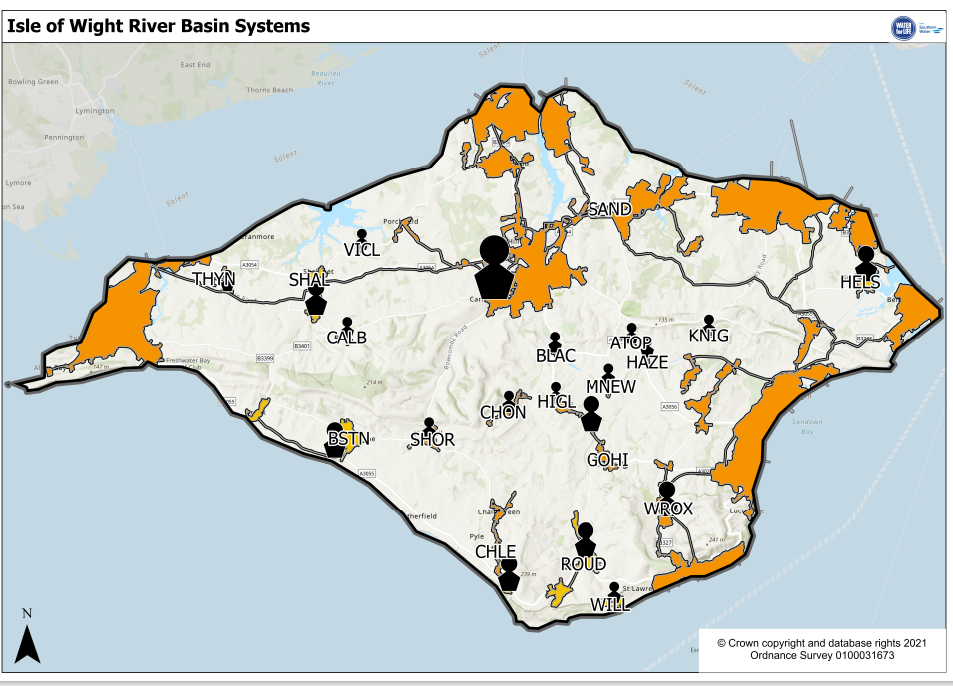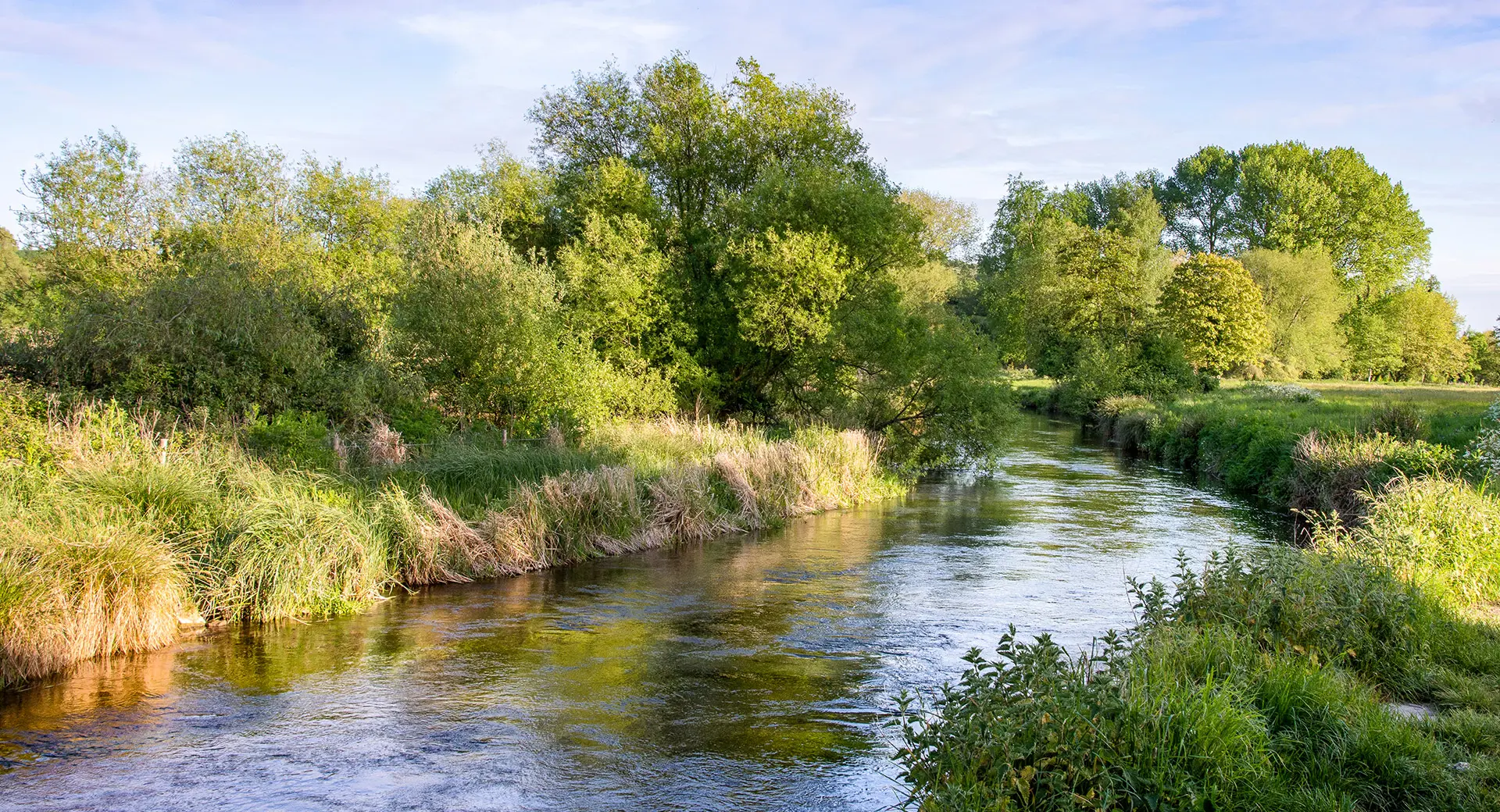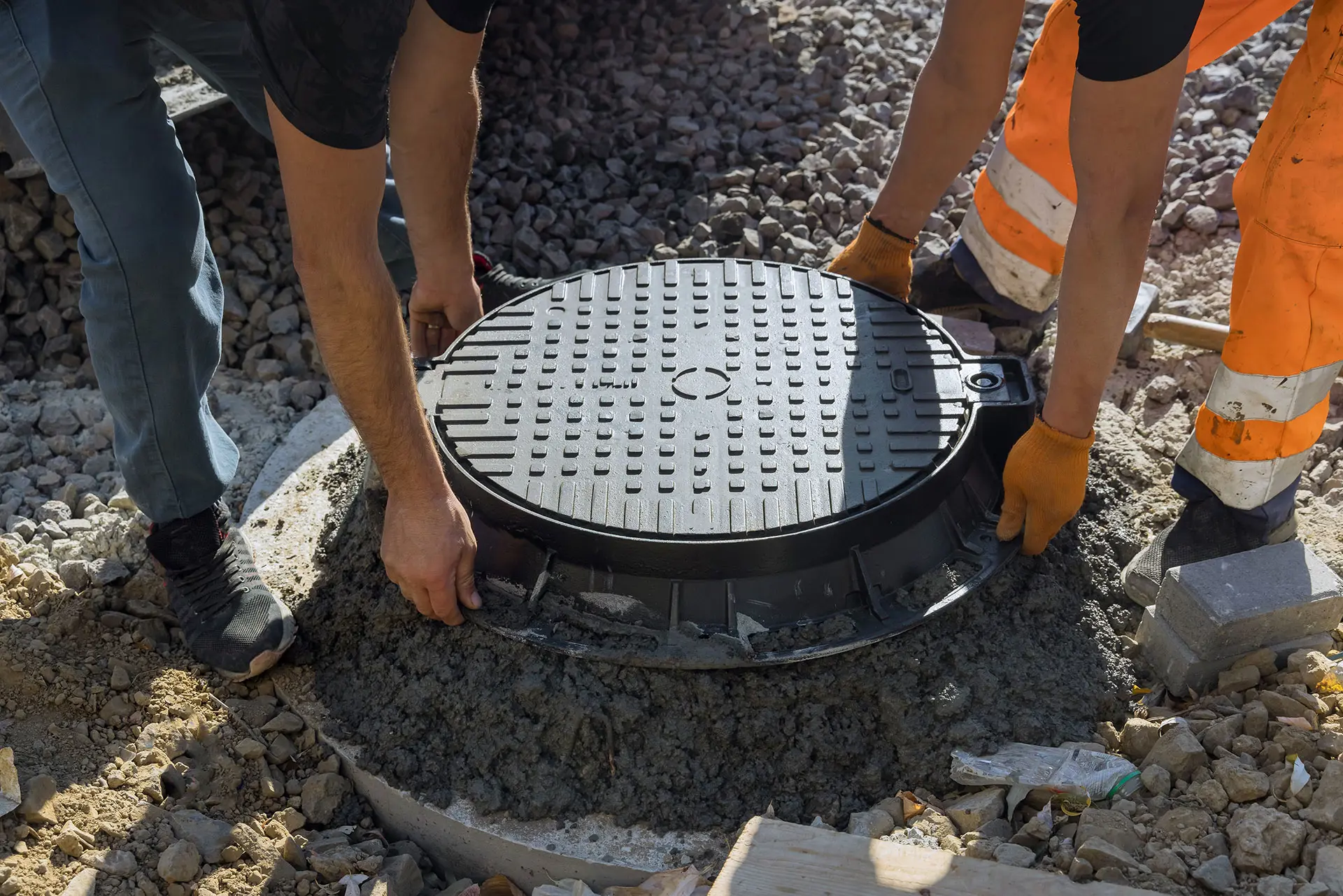1. Overview for the Isle of Wight River Basin Catchment
You can find all the documents relating to the below in the downloads at the bottom of this page.
Our DWMP sets out our priorities for the Isle of Wight River Basin Catchment.
- Reducing the number of spills from the 103 storm overflows which together currently spill around 2,400 times per annum.
- Separating or attenuating excess rainwater in the sewer networks to reduce the risks of flooding and frequency of storm overflow discharges, especially in Sandown, Ryde, Cowes, Fairlee, Dodnor and Roud.
- Investigating the impact of wastewater discharges on the Solent and Dorset Coasts and Isle of Wight lagoon.
- Investigation of land stability issues in vulnerable urbanised coastal landslide complexes, including Ventnor and the north coast and the potential impact on local infrastructure.
- Improving the resilience of our networks and treatment works to prevent pollution incidents, particularly in Ryde, Cowes, Sandown and Newport.
- Reducing the risk of sewer blockages by increasing sewer jetting and targeting customer campaigns to reduce the amount of FOG (fats, oils and grease) and non-flushables in the sewer network around Cowes, Sandown, and Newport.
Across the Isle of Wight, we have:
All the stages we followed in developing the DWMP for the Isle of Wight are set out in the subsections below.
Across the Isle of Wight, we have:
All the stages we followed in developing the DWMP for the Isle of Wight are set out in the subsections below.
20
Sewerage catchments
1,455
Kilometres of sewers
20
Wastewater Treatment Works
168
Wastewater Pumping Stations
13%
The percentage of the region connected to a mains sewer
95%
The percentage of homes connected to a mains sewer
89%
The percentage of businesses connected to a mains sewer
2. Working with others
We've worked with a wide range of organisations with responsibilities for drainage, flooding and protection of the environment while developing our DWMP. The organisations we worked with in the Isle of Wight include:
- The Isle of Wight County Council
- The Environment Agency
- Natural England
- The Island Rivers Catchment Partnership and member organisations including:
- The Hampshire and Isle of Wight Wildlife Trust
- Natural Enterprise
- Solent Forum
- The Country Landowners Association
- National Farmers Union
- Marine Management
Working together to co-create the DWMP is important. Our drainage and wastewater systems are often interconnected with the systems managed and operated by others and affect the natural environments within the catchment.
Issues and concerns
A wide range of issues and concerns have been raised and discussed throughout the development of the DWMP for the Isle of Wight.
- The majority of the IoW is a combined sewer system with lots of sub-catchments connected to the Sandown WTWs which serves 120,000 of the 140,000 population. Consequently, there's a huge reliance on it. There are process benefits, but there are significant pressures on the system, for example, pumping over large distances, costs, energy consumption, gases, bursts, odours and spills. The longer-term implications of these pressures and the wider impacts on the critical infrastructure of the IoW must be considered.
- Infiltration is a general issue across the IoW and is exacerbated by tidal influence. Investigations are needed to identify exactly where infiltration and/or tidal ingress is taking place.
- Some coastal pumping stations and works are protected by sea walls/defences and these, along with any esplanade access routes, need to be protected.
- The IoW is subject to landslips and coastal erosion. So, the benefits of protecting these assets should be factored into the costs of any proposed schemes to help secure government funding for flood defence and coastal protection schemes where contributions are required from several partners.
- We need to ensure leaking sewers do not exacerbate landslips and coastal erosion.
- The balance of water and the whole life costs of water management need to be taken into account. The DWMP for the Isle of Wight presents an opportunity to develop a high level strategy or plan for water, including recycling and re-capturing water.
- The Solent has a deteriorating water environment and many treatment works discharge into it, not just those on the IoW. The cumulative impact of these on water quality, habitats and biodiversity is severe and must be addressed.
- There are many other environmentally sensitive areas on the IoW where the impact of effluent on achieving GES needs to be investigated.
We're progressing these issues through the development of the DWMP as set out in our investment needs for the Isle of Wight. Furthermore, we commit to working with others to co-develop and co-deliver schemes that meet multi-organisational objectives and which benefit the environment, our customers and communities.
3. Workshop presentations
We developed and ran a series of activities between 2020 and 2022 as we prepared our DWMP for the Isle of Wight. This included regionally-based workshops that presented and discussed issues and information relevant across the whole of our operating region.
Workshop 1
Held in September 2020, participants discussed the findings of the risk based catchment screening (RBCS) and proposed additional planning objectives for the DWMP.
Workshop 2
Held in April 2021, participants:
(a) discussed the results from the BRAVA risk assessments and the proposed investment strategy for the wastewater catchments within the River Basin
(b) identified the generic options that should be explored to address the identified risks, and
(c) discussed which wastewater catchments to progress through the Options Development and Appraisal stage of the DWMP.
Workshop 3
Held in March 2022, we reviewed and discussed the draft investment programme for the Isle of Wight River Basin Catchment. This included the types of investment, priorities and timing for investment needs and the wider opportunities arising from the proposed investment in terms of partnership projects and catchment-wide solutions providing multiple benefits.
Workshop presentations can be download at the bottom of this page and you can view the findings from our interim consultation.
4. Risk based catchment screening for the Isle of Wight
Risk based catchment screening (RBCS) is a process that uses existing, readily available data. This is used to identify where there's a current and/or potential risk or vulnerability in the sewer catchment to future changes, such as new residential development or changes in climate. This enables effort to be focused on these catchments during the development of the DWMP in order to understand these risks in more detail and why they're likely to occur.
The RBCS involves the assessment of each sewer catchment against 17 indicators set out in guidance published by Water UK. Water companies can add additional indicators to ensure that other important issues are highlighted at this early stage in the development of the DWMPs. We've included an additional metric on customer complaints as this provides a flag for catchments with ongoing or outstanding concerns.
Find out more about the risk based catchment screening process.
5. BRAVA for the Isle of Wight Catchment
The Baseline Risk and Vulnerability Assessment (BRAVA) is an important step in the development of our DWMP in order to understand current system performance and future vulnerabilities. This understanding means that we can identify the investment needed to manage and reduce the risks to band 0 (no significant level of risk).
A BRAVA assessment has been completed for each of the wastewater systems in the Isle of Wight that were flagged during the risk based catchment screening (RBCS). A risk assessment is completed for all 14 planning objectives.
The output of the BRAVA shows:
- the current risks and issues in each wastewater system within the Isle of Wight catchment. This provides a baseline from which we can assess future risks the future risks in 2030, 2035, 2045 and 2050 (where the methodology currently allows us to assess the future risks) so we can understand how the current risks may change without additional investment.
- the key issues behind the future changes in risk, including:
- a deterioration in the condition of our wastewater systems
- climate change – including the increasing frequency and severity of droughts and storms
- growth and urban creep
- a combination of any or all of these that are relevant in the catchment being assessed.
You can download the BRAVA results for the Isle of Wight River Basin Catchment at the bottom of the page.
Notes
- In the BRAVA results table, “not flagged” means no risks were identified in the initial RBCS using the nationally set criteria. Wastewater systems not flagged were screened out and did not progress to the BRAVA stage. “Not applicable” means the planning objective was not relevant within the wastewater system. For example, where a system has no storm overflows, this will be marked as “Not applicable”.
- Please check the DWMP glossary for any unexplained acronyms.
6. Problem Characterisation
The Problem Characterisation stage of the DWMP uses the results from the Baseline Risk and Vulnerability Assessment (BRAVA) to explore the causes of risks and the primary drivers. A technical summary provides information on our approach to the Problem Characterisation stage.
Current risks in the Isle of Wight
The combined results of the 2020 BRAVA assessment for all 20 wastewater systems on the Isle of Wight shows how many wastewater systems have a risk under each of the 14 planning objectives. For example, for the risk of internal flooding, 14 wastewater systems are in band 0 (not significant), there is one in band 1 (moderately significant), and none in band 2 (very significant). Five were ‘not flagged’ for inclusion (i.e. screened out at the RBCS stage of the DWMP).
Storm overflow performance, Dry Weather Flow Compliance and nutrients are the main concerns in this river basin.
The wastewater system with the highest number of planning objectives in band 2 (very significant) is Sandown with seven objectives in band 2. This is one of three wastewater systems in our operating area with this level of risk for 2020. So, Sandown is a high priority for future investment to reduce these risks. Godshill has three band 2 risks, and Wroxall, Roud, St Helens and Brighstone each have two objectives in band 2. All other catchments have fewer risks.
We're focusing our attention on Sandown in the first cycle of the DWMP as it has such a large number of risks.
Future risks in the Isle of Wight
The 2050 BRAVA results help us to identify the future challenges for drainage and wastewater management on the Isle of Wight.
(a) Growth
New homes, businesses, roads and other infrastructure are planned in many locations across the Isle of Wight, mainly in the coastal settlements and in Newport. The new development is anticipated to be more than 2,000 homes by 2050.
This additional development may mean that our current permits for wastewater treatment quality might be exceeded by 2050 without further investment. However, many of these areas are serviced by the Sandown Treatment Works and the BRAVA results show that the risks at Sandown need investment in the shorter term to address the current risks.
The BRAVA results show that the additional homes and businesses will increase the risks of non-compliance with our Dry Weather Flow (DWF) permits from the Environment Agency in the St Helens wastewater system. This means further investment will be needed in the future to increase the capacity of our treatment works to accommodate the additional flow from new homes and businesses.
New development on the Isle of Wight might put additional pressure on the internationally designated habitat sites in the Solent. So, solutions will need to be found to ensure that development is nutrient-neutral.
A map of the Isle of Wight showing the estimated future growth in each wastewater system is shown below. The technical summary explains how we considered population growth and urban creep in our DWMP.

(b) Climate change
Climate change will bring greater variability of our weather with warmer wetter winters and hotter drier summers. As such, we could be seeing more intense summer storms that exceed the capacity of the drainage and wastewater networks and cause localised flooding. Hence, the risk of flooding from sewer systems is increasing due to climate change. The technical summary explains how we've considered climate change in our DWMP.
We'll work with partner organisations, such as the Isle of Wight County Council and the Environment Agency, who have responsibility for flooding and drainage, to consider options and develop opportunities to find solutions that reduce the risks from flooding.
We'll need to adapt our wastewater systems to operate in future climates. There will be an increasing need to slow the flow entering our sewer networks so the systems can carry the water without flooding homes and businesses and/or without causing discharges from storm overflows. Preventing additional rainfall entering foul sewer networks, including combined sewer networks where possible, could delay the need to upgrade and enlarge the vast underground network of sewers.
Climate change is expected to have an impact on the risk of flooding in several wastewater systems, especially Sandown, Brighstone, St Helens and Chillerton where there is already a very significant risk from rainfall-related flooding. All these wastewater systems are located around the coast of the island. The flooding risks will increase by 2050 unless measures are taken to manage and reduce these risks. The BRAVA results indicate that the risk of storm overflow discharges for six of the wastewater systems is likely to increase to very significant unless further action is taken.
The map below shows the potential impact of climate change, urban creep and growth on the risk of flooding in a 1-in-20-year storm for the Sandown wastewater system. We followed Water UK’s capacity assessment framework to apply a 20% uplift to rainfall forecasts to assess the potential increases in flood volumes shown on the map. Urban creep was estimated using the approach developed by the UK Water Industry Research (UKWIR) report on Urban Creep in sewerage systems (2010). The flood volumes generated by rainfall over the area covered by this wastewater system could increase from 58,656m3 in 2020 to over 99,435m3 by 2050.

The map highlights that we'll need to adapt to climate change. Adaptation will mean considering long-term sustainable options, such as reducing the volume of rainwater entering the sewer network. This approach may provide the capacity within the wastewater system to allow for future growth and therefore reduce both the need for significant increases in the capacity of the existing wastewater systems and reduce discharges from storm overflows.
Investment planning for each wastewater system
We used the BRAVA results and our understanding of the causes of risks and drivers to propose an investment strategy for each of the wastewater systems. Find out more information on how we determined the investment strategies. These strategies help us to target the wastewater systems that need further investment to reduce the potential risks to customers and the environment. We've produced a table that lists the proposed investment strategy for each catchment.
We used a risk-based approach to identify the wastewater systems that we need to progress in this first round of DWMPs. For these systems, we'll develop an investment plan. Our technical summary sets out how we selected the systems to take forward.
We're progressing the Sandown wastewater system during this first round of the DWMP into the investment planning stage. Information on the other wastewater systems on the Isle of Wight will be added soon.
7. Options Development and Appraisal
Our approach to Options Development and Appraisal (ODA) is explained in the technical summary.
Generic options
We commenced the ODA process at the river basin catchment (RBC) scale (level 2 planning). This enabled us to look across all the wastewater systems in the river basin and consider generic options that could work at the catchment scale, as well as those specific to a wastewater system.
The generic options are grouped into those that help tackle the risks at ‘source’, those that help to improve the wastewater system, ‘the pathway’, and those that protect or mitigate the impacts on the receiving waterbodies, ‘the receptors’. This process helped to identify the types of options that could be used individually or in combination with other options to address the risks.
We held meetings with partner organisations to build upon the list of generic options relevant to each wastewater system. As a group, we identified and proposed ‘unconstrained’ options to tackle the drivers and causes of risks identified during the Problem Characterisation stage of the DWMP. We then progressed these unconstrained options through the Options Development and Appraisal stage.
Options development and appraisal
The options appraisal involved evaluating each of the options in two stages. Firstly, to screen out unviable options to leave a set of ‘constrained’ options, and then a second stage to reduce the list further to leave only potentially ‘feasible’ options (see the Options Development and Appraisal technical summary for full details of this process). The process for evaluating the benefits and how we've taken the environment into account is set out in our Strategic Environmental Assessment (SEA) Scoping Report and the SEA Progress Report.
Only feasible options with positive benefits proceeded to the costing stage. This resulted in the selection of the preferred options and confirmed whether each was ‘least cost’ or provided ‘best value’.
The documents in the links below show the feasible options and how we applied the process within each wastewater system. Beginning with the generic options through the appraisal stages, the tables show the point at which some options were rejected and why. If an option wasn't rejected, it was costed and became either the final best value or the least cost preferred option (see ODA technical summary for details of this process).
Our final preferred options are set out in the investment needs tables for each wastewater system. The accompanying maps show the location of the proposed options within the wastewater system.
Please check the DWMP glossary for any unexplained acronyms.
The options and investment needs are not committed funding but an identification of the needs for funding. We'll include these options in our future business plans as part of the Ofwat periodic review of water company funding to secure the investment needed to implement them.
8. Programme Appraisal
The Programme Appraisal stage of the DWMP follows the Options Development and Appraisal (ODA) process which identified the preferred options for investment in our wastewater systems to reduce the current risks as well as the risks up to 2050.
The Programme Appraisal brings the investment needs for each wastewater system together into an investment needs programme for the Isle of Wight Catchment. We look across the catchment to review the investments needed, the timing of these needs and how they combine to reduce the risks to our customers and the environment.
We also look at the wider risk reduction that each option provides across all the planning objectives. Some actions, like separating rainwater from wastewater sewers, could reduce risks under several planning objectives such as storm overflows, external flooding, bathing water quality, shellfish water quality and good ecological status. The details of the method for prioritisation can be found in our Technical Summary on Programme Appraisal.
The investment needs for the Isle of Wight Catchment include:
- reducing the number of spills from the 103 storm overflows which together currently spill around 2,400 times per annum
- separating or attenuating excess rainwater in the sewer networks to reduce the risks of flooding and frequency of storm overflow discharges, especially in Sandown, Ryde, Cowes, Fairlee, Dodnor and Roud
- investigating the impact of wastewater discharges on the Solent and Dorset Coasts and Isle of Wight lagoon
- investigation of land stability issues in vulnerable urbanised coastal landslide complexes, including Ventnor and the north coast and the potential impact on local infrastructure
- improving the resilience of our networks and treatment works to prevent pollution incidents, particularly in Ryde, Cowes, Sandown and Newport
- reducing the risk of sewer blockages by increasing sewer jetting and targeting customer campaigns to reduce the amount of FOG (fats, oils and grease) and non-flushables in the sewer network around Cowes, Sandown, and Newport.
Investment Needs for the Isle of Wight River Basin Catchment
We progressed only the Sandown wastewater system through the ODA stage in the first cycle of the DWMP. Sandown serves a population of around 131,000 which is approximately 90% of customers in the Isle of Wight catchment.
We extrapolated the investment needs for Sandown to the other 19 systems in the Isle of Wight catchment. This provides an estimate of the total investment needs required to reduce the risks in all our wastewater systems in the catchment to band 0 (not significant). This concept of “Band Reduction” and full details of the process for extrapolation are explained in the Technical Summary on Programme Appraisal.
The Programme Appraisal for the Isle of Wight identified the following needs.
- A total of 17 band reductions are required in 2020 to reduce the risks across the 14 planning objectives for Sandown – the one wastewater system on the island that was considered in the first cycle of DWMP.
- By 2050, this requirement will stay the same at 17 band reductions even taking climate change, growth and creep into account. Although the risks will increase, this is not visible where the risk is already in the highest risk band 2.
- The options identified to date would cost around £288 million for Sandown and are expected to provide eight band reductions in 2050 (the options do not result in a band 0 for all risks).
- On the Island, there are 20 wastewater systems which need 72 band reductions in 2020 and 78 by 2050 in order to achieve band 0 across all 14 planning objectives.
- Extrapolating the investment needs for all the systems on the IoW will cost around £637 million for a population of 144,000. This illustrates the scale of investment needed to get to band 0 by 2050 for all 14 planning objectives.
These investment needs provide indicative costs that allow us to understand the level of funding required to reduce the risks. The funding hasn't been secured at this stage. The DWMP informs the development of our 5 yearly Business Plan which is submitted to our economic regulator, Ofwat, to agree on how we should invest the money received from our customer bills.
Consultation on the Isle of Wight River Basin Catchment
We held a preliminary consultation on our draft DWMP in September and October 2021. The purpose of the consultation was to gain feedback and advice from our customers and organisations on our developing Plan.
We specifically asked about:
- our Strategic Environmental Assessment Scoping Report
- our selection of wastewater systems to take forward into the Options Development and Appraisal stage of the DWMP in the first cycle, and
- our developing plans on each of the 11 river basin catchments.
Our report on the initial DWMP consultation is now available.
When we consulted on the developing plans for the Isle of Wight, you highlighted key issues for us to take into consideration.
- The DWMP should develop a whole life water cycle approach joining up surface water/wastewater recycling with water supply.
- Wider opportunities to align with other economic and environmental strategies that consider how we manage issues such as summer water shortages, reducing carbon use, improving/increasing nature corridors and achieving nutrient neutrality should be part of the DWMP.
- Capacity issues at Sandown must be addressed to support new development.
- Combined systems should be separated to prevent flooding and new development should be prevented from draining surface waters to sewers.
- Flooding hotpots should be mapped.
- Shared funding for an enforcement officer should be considered to ensure planning guidelines on creep are not contravened.
How we responded to the issues raised during the workshops and the preliminary public consultation is set out in our Register of Stakeholder Comments.
We held a full 12-week public consultation on the draft Regional (Level 1) DWMP between Monday 13 June and Monday 05 September 2022. Our Statement of Response and a report and analysis on the consultation is published on the Have your say page.




